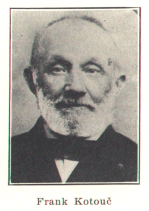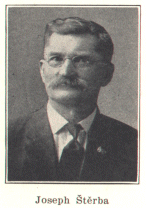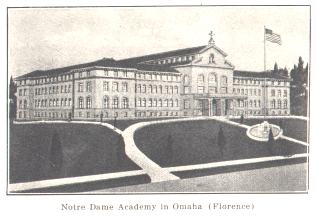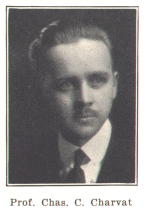 |
Schools(Part 1) |
This is a NEGenWeb Project web page
and is presented as part of the
MARDOS Memorial Library Collection.
Schools
(Part 1)
|
Love for one's native land and language is natural, but it is much stronger in people living in countries subjected to the rule of an alien government. Bohemia is a notable example of this truism. Despite the efforts of the Austrian (German-language) government for two hundred years to stamp out the Czechs' language, it never died but revived again in its full purity and beauty. What wonder then that emigrants to our shores brought with them this love for their native tongue and tried to keep it alive here for their children? However, they never forgot their duty to this country and sent their children to public school regularly. This applies to the time before Catholic schools, where Czech is taught, were established, and that time came much later, the first such school, in Dodge, having been established by Rev. John St. Broz in 1911. The Liberals, while sending their children to the public schools, prepared for them Czech-language schools for Saturdays and in some cases Sunday forenoons. Miss Sarka Hrbkova, in an address held on July 4, 1917, in Krug Park, Omaha, very aptly summed up their attitude when she said: "I should be ashamed if I could not speak to my mother in the language in which she first spoke to me, but I should be equally ashamed, if my mother had not seen to it that I received an education in English, the language of my country." These little Czech-language schools were sponsored mainly by lodges and the teachers were men (women but exceptionally, for the men had in a larger measure the necessary education) who devoted themselves to the work for a very modest stipend. Occasionally a summer term was held, school being in session forenoons during the summer vacation. This is still being done, for instance in Schuyler, and Clarkson. As a rule, the children did not take kindly to it, and looking at it from their view, we cannot blame them. They did not have the feeling about the language that the parents had, and they felt it an encroachment upon the time belonging to play and vacation. A very natural feeling, although painful for the parents. In 1913 a law came into being that provided for the teaching of any modern language in every high school, city or metropolitan school. Upon the written request of parents or guardians of fifty pupils above the fourth grade then attending school, the authorities were allowed to employ competent teachers and provide for the teaching, above the fourth grade, as an elective course of study, of such modern European language as was designated in the request. Provided that not more than five hours each week and not less than one period each day be devoted to the teaching of such language in any elementary or grade school. As early as 1907 a Slavonic Department has been established in our State University. More detailed mention of this is given in the paragraph describing the Komensky Clubs. The law described above (1913) resulted in Czech being taught in the following accredited schools:
The above is taken from official records and there probably were other similar cases. For instance, Miss Anna Svacina taught Czech an hour daily in Comenius School in Omaha about that time. Mr. John F. Spirk taught Czech in the Wilber High School. And even before this law was created, Czech was taught one-half day in the week in several strongly Czech towns, like Prague. However, the war came on and feeling ran high, so that in 1919 the so-called Siman law was passed, reading, in part, thus: "No person, individually or as a teacher, shall, in any private, denominational, parochial or public school, teach any subject to any person in any language than the English language." In 1921 the so-called Norval law was passed, making the Siman law even more stringent. However, in June, 1923, the United States Supreme Court held it unconstitutional and a violation of the Fourteenth Amendment. But a natural law, more potent than any legal law, is working toward the obliteration of foreign languages in this country, for with the second and third generations the language of the ancestors dies out. We are speaking now of language as used commonly. Those who care to study foreign languages are the exception and not the rule. Following is a list of Czech (Liberal) schools, which undoubtedly is incomplete, but is the best that could be done at this date. Of the teachers, all of whom taught more for love than gain, Jos. Sterba stands first, having taught in South Omaha for twenty-eight years, while Frank Kotouc of Humboldt taught there twenty years.   1873:--The first school on record, when Joseph Jindra began to teach Czech in a little log schoolhouse on Joseph Jelinek's farm near Crete, Saline County. In this same schoolhouse English was taught, as described in the chapter on teachers. Jindra was succeeded in 1875 by Miss Mary Jicha (later Mrs. Havlik) and she in 1876 by a Mr. Huncovsky. Then there was an interim until 1913 and 1914, when Vaclav Kacer taught in Crete in a school sponsored by Lodge Nebraska No. 3, Western Bohemian Fraternal Association. His wife, Minnie, a public school teacher, taught an hour daily, under the Siman law, but there was not enough interest to warrant continuance. Cuming County--Frank Pospisil Sr., taught in the early seventies in a schoolhouse across the river from West Point. 1877:--A school was established in Schuyler, Colfax County, by the Literary & Dramatic Society Tyl and Lodge Zapadni Jednota No. 42, Bohemian Slavonian Benevolent Society. Joseph W. Zerzan, Joseph Kubik, Vaclav Maly and Joseph Smatlan took turns in teaching, asking no pay. It may be noted here that the pay of any of these teachers was very small or nothing. Of these only Joseph Smatlan is living. As in other instances, the public school buildings were kindly loaned by the school authorities, gratis. Later the C. S. P. S. (Bohemian Slavonian Benevolent Society) hall was used, under the same conditions. In 1885 a board was elected, comprised of the following: Frank Otradovsky, president; Joseph Smatlan, treasurer; F. J. Kovar, secretary; Joseph Maly, financial secretary. The first paid teacher was John H. Steiger, who taught two days per week for five dollars per month. The following year he taught three days in the week for $15.00 monthly. A. Z. Donato succeeded him to 1888, when he was followed by J. Em. Kroupa, and then returned to his old post again. There was an interim until 1892, when F. L. Fuks taught, followed by A. Z. Donato. In 1894 V. Kadlec had charge, an interim of two years followed and in 1897 A. Z. Donato was once again in charge. In 1898 John Zabka, an interim following and in 1900 F. Dagobert Novak, 1901 F. H. Svoboda and again an interim. In 1904 V. Miniberger taught, then to 1908 Rudolph Fibinger. In 1909 F. Okrina and again an interim. In 1912 Karel Severin became teacher, an able pupil of the school itself, grown to manhood. In 1913 and 1914 Fr. Sedy taught, followed by Mr. Severin. In 1916 Miss A. G. Vanek came from New York to teach during the summer and in 1917 Miss Caroline Cilek. During the war there was a pause, then 1920--1921 Rudolph Kohlicek Hartwald from Chicago taught and the school changed to a dramatic club for young people. In 1922 to 1924 Bretislav Jonas from Chicago taught. From 1885 to 1892 the entire burden of maintaining the school rested upon the two lodges first mentioned. In 1892 the J. A. Komensky Camp (Modern Woodmen) and Lodge Vytrvalost of the Union of Bohemian Women joined, in 1893 the Tel. Jed. Sokol and Lodge Jan Hus, A. O. U. W., in 1897 Camp Svornost, W. O. W. and in 1901 Woodmen Circle also joined. In 1901 the Literary and Dramatic Club Tyl disbanded and donated the amount in its treasury ($50.00) to the school. The following societies were added to the list of patrons: Dancing & Pleasure Club, Lodge Blanik (Western Bohemian Fraternal Association) and in 1907 Vlastenky, the Ladies Sokol Club. Aside from contributions of the lodges and clubs, the school was maintained from proceeds of entertainments, picnics, theatricals, etc., arranged by the teacher. In 1886--1900 Mr. A. Z. Donato (elder) established a private school for the teaching of Bohemian, and both schools prospered together. The teacher's salary was gradually raised, until in 1923--1924 it reached $144.00 per month, school being taught during the summer vacation. On the average fifty pupils were enrolled, forty attending daily. This looks very hopeful, it would seem and yet Joseph Sudik, who has furnished this data, adds: "But all in all, the end will come, for Czech national feeling is dying out." 1878:--A school was established in Wilber, Saline County, and among the teachers were: V. J. Stedry, Peter Safarik, Frank Cetlovsky, V. A. Jung, Charles Jindra and S. L. Kostoryz. It ceased to exist years ago. 1880:--From 1880 to 1882 Joseph V. Holecek taught Czech and English in Niobrara, Knox County, on Sundays, during six winter months. About 1896 Miss Anna Jelen taught one summer in Verdigre, and later, during 1913 and 1914, Miss Marie Tikalsky and A. V. Kouba taught during vacation. About 1910 a cigar maker named Donat also taught. In Pishelville a Mr. Vonasek taught about 1906. 1881:--A school was established in Omaha, which, except for two interims, has been in existence ever since. On December 11, 1881, a meeting was held in Svacina's Hall and the following were present: Fr. J. Kaspar, V. L. Vodicka, Frank Vodicka, George Hoffman, Vaclav Jablecnik, Frank Jelen, Vaclav Fiala, Cenek Hrabik, Frank Serbousek, A. Hajek, A. Francl, John Svacina, Ladislav Fliegel and John Rosicky. The Omaha School Board donated the use of the school-room in Holub's building, corner 13th and William streets, where Prague Hotel now stands, gratis. The first teacher was Ladislav Fliegel, who taught about a year and then moved to Chicago. He was followed by V. A. Jung and T. Capek, in 1885 by Joseph Dinebier, who taught until his death, in 1889. Dinebier, with possibly the exception of Rudolph Fibinger, who came many years after him, was the best beloved of all the teachers. Both men died young and both were victims of tuberculosis. Dinebier was succeeded by Miroslav Racek. In 1890 a school house was built on ground donated by Mr. Joseph Michal, near 12th and Pacific streets. The Tel. Jed. Sokol and other lodges helped defray expenses. Mr. Racek was succeeded by J. A. Hospodsky, Rev. J. Pipal, J. F. Pribyl, L. W. Dongres, J. V. Masek and Mrs. E. Bandhauer. Toward the close of the nineties the school was closed for a while. When the Tel. Jed. Sokol built its hall on 13th street near Dorcas, the building was moved there. Three grades were instituted at that time, Joseph Bunata and Vaclav Bures taught the first, Charles Stenicka the second and J. V. Masek the third. After Mr. Bunata's departure Karel Stenicka and Fred Slama continued the work. Their successor was Rudolph Fibinger. After his death Alois Korisko became teacher and then in succession the following: Mrs. Al. Korisko, John Klipa, John F. Prachensky, Joseph Ruzicka, Ladislav Tkadlec. The last two are at present still active, each teaching one class. 1883:--The school in Humboldt, Richardson County, was established and Frank Kotouc taught until 1903, twenty years. He was succeeded by Bohuslav Ningr, who taught until 1906. 1892:--The school in Morse Bluff, Saunders County, was established when Joseph Prai taught one year in Frank Hines's hall. In 1904 Frank Kaplan taught in summer in School District 54, on Sundays. In 1912 Miss Gizela Lawetz taught on Saturdays and was succeeded in 1913 and 1914 by Frank Lorenc, also on Saturdays. 1892:--Lodge Zapadni Svornost 147, Bohemian Slavonian Benevolent Society (now Zapadni Svornost 28, Western Bohemian Fraternal Association) established a school in its hall, in Clarkson, Colfax County. Anton Odvarka Sr., taught Sunday forenoons. Later Czech was taught one hour each on Friday forenoons in the public school by the Misses Nettle Aksamit, Stella Folda and Supt. Fred Jelinek. in turn. A few years later, at the instigation of several lodges, the period was enlarged and Anton Odvarka Sr., assisted by Miss Louise Dusatko, taught. Joseph A. Kucera taught one year, during summer vacation, three days a week. During the war all such activity ceased and in 1920 the Czech school was reopened under the guidance of Rev. B. A. Filipi, the Presbyterian minister, and has continued since, the periods being four half days a week and eight weeks in summer vacation. During the winters between 1901 and 1904, Joseph Krikac taught Czech and English in an evening school. The number of pupils on the average was thirty and their ages varied from ten to forty-five years. The district paid the heat and light and the pupils paid Mr. Krikac $1.00 per month each. Sessions three evenings each week, four months in the year. 1894:--A school in Pawnee County was established, being in session Sunday forenoons during the summer vacation. John Nedela taught in a German Evangelical church in the country, near the Richardson County boundary. The rent was free and the teacher donated his services. In 1896 another school was founded four miles northwest of DuBois, in a community hall, being in session Sunday forenoons during summer. It continued for three years, the tuition fee being twenty-five cents per month, the teacher receiving $1.00 for each session. Forty pupils attended and F. G. Dobrovolny taught, then a young man, who walked three miles to school. When Lodge Jan Kollar No. 101 of the Western Bohemian Fraternal Association was founded in DuBois, in 1900, it sponsored a Czech school in School District No. 31, under F. G. Dobrovolny. At present there is no Czech school in DuBois. In 1905 and 1906 and again in 1911 and 1912, Lodge Premysl Otakar II, No. 84, Western Bohemian Fraternal Association, sponsored a school in Table Rock and all that time Mrs. A. R. Kovanda taught. About fifty-four children were enrolled with an average attendance of thirty-six. 1894:--A school was established in South Omaha, sponsored by the Lodge Hvezda Svobody (Bohemian Slavonian Benevolent Society), Lodge Olivova Ratolest (Union of Bohemian Women) and Tel. Jed. Sokol, in Brown Park schoolhouse, during the summer vacation. Bohumir Horacek taught four days per week, having two classes of ninety children. The course included: reading, writing, history, Czech songs, arithmetic and geography. After vacation a number of old seats were purchased from the school board and a school-room fitted in an empty store building on 21st and S streets, where school was taught for several years, until the National Hall was built on 21st and U streets. Horacek was succeeded by F. S. Fitl, he in turn by Joseph Sterba, the present teacher, who has been faithful to his post since 1898, making him the oldest teacher, of this kind, in years of service, in the state. 1899:--The school in Boyd County was taught by Anton Basta during one summer. 1900:--The school in Howell, Colfax County, was established, sponsored by Lodge Svoboda No. 60, Western Bohemian Fraternal Association and the parents. The first teacher was Anton Rysavy and was followed by Miss Louise Dusatko, who used to come from Clarkson. Later Prof. Srb taught in the public schoolhouse. 1907:--A school was established in Brainard, Butler County, under the tutelage of Prof. Fred Jelinek, maintained by the parents, but is not now in existence. 1916:--A school was founded in Ord, Valley County, with an average attendance of thirty pupils. Miss Ludmila Kupec taught during the three summer months. Since then Czech was not taught until 1925, when Rev. Cejnar, a Presbyterian minister, taught during the three summer months in the hall belonging to Lodge Dennice No. 14, Western Bohemian Fraternal Association, about thirty-five pupils attending. The hall was used gratis. In the earlier days Joseph Krikac taught Czech in School District 63 of Valley County, in 1895 and 1896. He gave to this work two hours on Monday, Wednesday and Friday of each week, for three months. The district school board did not charge anything and Mr. Krikac also gave his services gratis. About forty children attended. 1916:--A school was maintained in Virginia, Gage County, for one year, by Lodge Osveta No. 94 and Sumava No. 130 of the Western Bohemian Fraternal Association, in a building one mile east and two miles south of Virginia. Vojtech V. Habrich taught and the session was held on Sundays, with about forty-five pupils attending. 1916:--Howard County--C. V. Svoboda, St. Paul, established a school which was discontinued in 1918.  While the Liberals confine themselves to teaching Czech outside of public-school hours, the Catholics teach it as part of the regular course in their schools, as listed below. As will be seen, with the exception of the St. Wenceslaus school in Omaha, all are being taught by Sisters de Notre Dame, the Czech branch. This congregation was founded by St. Peter Fourier in Lorraine, Europe, in 1597 and was introduced into Bohemia in 1853 by Father Gabriel Schneider. Five sisters of this Community, headed by Mother Mary Gualberta, came to this country in 1910, at the request of the Rev. C. A. Bleha of St. Louis, Mo. One year later Rev. John St. Broz invited the sisters to conduct a new Catholic school in Dodge, Nebraska, where he was incumbent. Since that time, these Czech Notre Dame sisters were given charge of several other schools, as shown in the following. There are now fifty-four sisters, five novices and five candidates in the community. Their provicinal mother-house in Omaha, 35th and State Streets, was consecrated August 15, 1926, by Bishop Beckman of Lincoln, Mother Gualberta still in charge. The building is a two-thirds unit, costing $200,000 and houses an academy for young women, the first of its kind in the middle west. Brainard, Butler County:--A ten-grade and high school, with school of music in connection. Built in 1915, consecrated August 23, 1916, and sessions commenced September 5, 1916, with an attendance of 147 pupils. Later two grades were added (Junior High School) and in 1917--1919 there were 200 pupils. At present about 150 day and boarding pupils. Czech taught half an hour daily. Dodge, Dodge County:--An eight-grade school, built in 1911. Taught by Sisters de Notre Dame. 126 pupils attend. Omaha--St. Wenceslaus: Taught by four Sisters of Mercy. 210 pupils attend. Assumption of Blessed Virgin (South Omaha): Taught by six Sisters de Notre Dame. 300 pupils attend. St. Adalbert: Taught by three Sisters de Notre Dame. Eighty-five pupils attend. Prague, Saunders County:--Taught by three Sisters de Notre Dame and one secular teacher. 120 pupils attend. Schuyler, Colfax County:--School for music, art, foreign languages, etc. Taught by Sisters de Notre Dame. Wahoo, Saunders County:--A twelve-grade school. Business course taught also. Taught by Sisters de Notre Dame. 164 day pupils and sixty-one boarding pupils attend. The schools at Brainard, Prague and Wahoo are grade and high schools, that in Schuyler is for music, art, foreign languages, etc., the rest are grade schools. 
In the spring of 1924 Prof. Chas. C. Charvat, then teaching English in the Creighton University of Omaha, conceived the possibility of a Czech or Bohemian language department. He communicated with his former schoolfellow, Rev. Edward C. Chapuran, now pastor of St. Wenceslaus church, Omaha, who was entertaining a similar design. With the consent of Rev. John F. McCormick, president of the University, the project was continued. Early in June Prof. Charvat announced in the Omaha papers that Czech would be taught the following September and these announcements were repeated through summer. It was agreed that it would be best to begin with an elementary course, to be given in the evenings, thus enabling professional students and non-university students to take the course. Classes were begun with about twenty students and when the class was changed from evening to day sessions, at the end of the first semester, the number diminished somewhat, but the results in June were better than expected. Prof. Charvat and Rev. Chapuran agreed that it might be well to cultivate a spirit of national pride, before sufficient enthusiasm could be mustered for a successful Czech department and consequently, on December 10, 1924, a group of Czech students from the various colleges of the university organized the Czech Club. The names of twenty-five students were submitted and the immediate purpose of the club was to "further the study of the Czech language, literature and history, and to provide social entertainment." The ultimate purpose was to realize the wish of President McCormick: "To make Creighton University a center of Czech intellectual and cultural life in the Middle West." The officers elected were: Adolph Svoboda of Abie, Nebraska, president and Joseph S. Pallat of Wahoo, Nebraska, secretary-treasurer. Rev. Edward C. Chapuran was chosen faculty moderator. The first formal meeting occurred on December 17, 1924 and the late Rev. Monsignore John Vranek made an eloquent plea for a continuation of the Czech student activity at Creighton. Music, oratory, recitations and dancing were strong features of the Czech Club programs from the beginning. Other speakers who helped to make the Czech Club a success during the first year were: Dr. F. A. Sedlacek, Dr. Olga Stastny, Mrs. F. A. Sedlacek, Dr. F. G. Smola, Mr. Stanley Serpan, --all of Omaha and Mr. Frank Dolezal of Wahoo, Nebr. In the Summer School of 1925 at Creighton University, two courses of the Czech language, one elementary and the other advanced, were given and attended by twenty-two students. In September 1925 two Czech courses were initiated and conducted successfully through the year by Rev. Edward Chapuran. One was a day course in elementary Czech and the other an evening course in Czech literature. October 29th the Czech Club was reorganized with Joseph S. Pallat, president, Roman Hruska, Omaha, vice-president, Miss Irene Tauchen, Omaha, secretary-treasurer and John Cacek of Cedar Rapids, Iowa, chairman of the entertainment committee. Prof. Charvat was chosen faculty moderator. The prospects for the second term were very encouraging. Two hundred Czech books of fiction, biography, poetry, history and drama were received from the Ministry of Education of Czechoslovakia, upon the recommendation of Mr. Stanley Serpan, Czechoslovak Consul in Omaha and a similar donation of thirty books was received from the Chicago headquarters of the National Alliance of Bohemian Catholics in America, with smaller donations by individual friends. Prof. Charvat, who has furnished the data about the Czech Department and Club, says: "While the future of the Czech Department is promising, I cannot refrain from saying that the sum total of the little difficulties which persisted in besetting the path which Rev. Chapuran and I had to tread until now, has on more than one occasion been sufficiently discouraging to make me wish to abandon the work. Fortunately when the enthusiasm of one chanced to ebb, the other was aglow with fresh zest and in that manner a perpetual interest was maintained in support of the venture." While this department and club, says Prof. Charvat, has done good work in stimulating young Czech-Americans to concern themselves with the intellectual and cultural value of their original nationality; has won admiration of many Czechs in the middle west; has brought publicity of the best kind for the university, -- for its continued success it would be desirable to have one person devote all his time, or the major part of it, to this work. Both Rev. Chapuran and Prof. Charvat have been able to give it but their spare time. |
| Back | Table of Contents | Next |